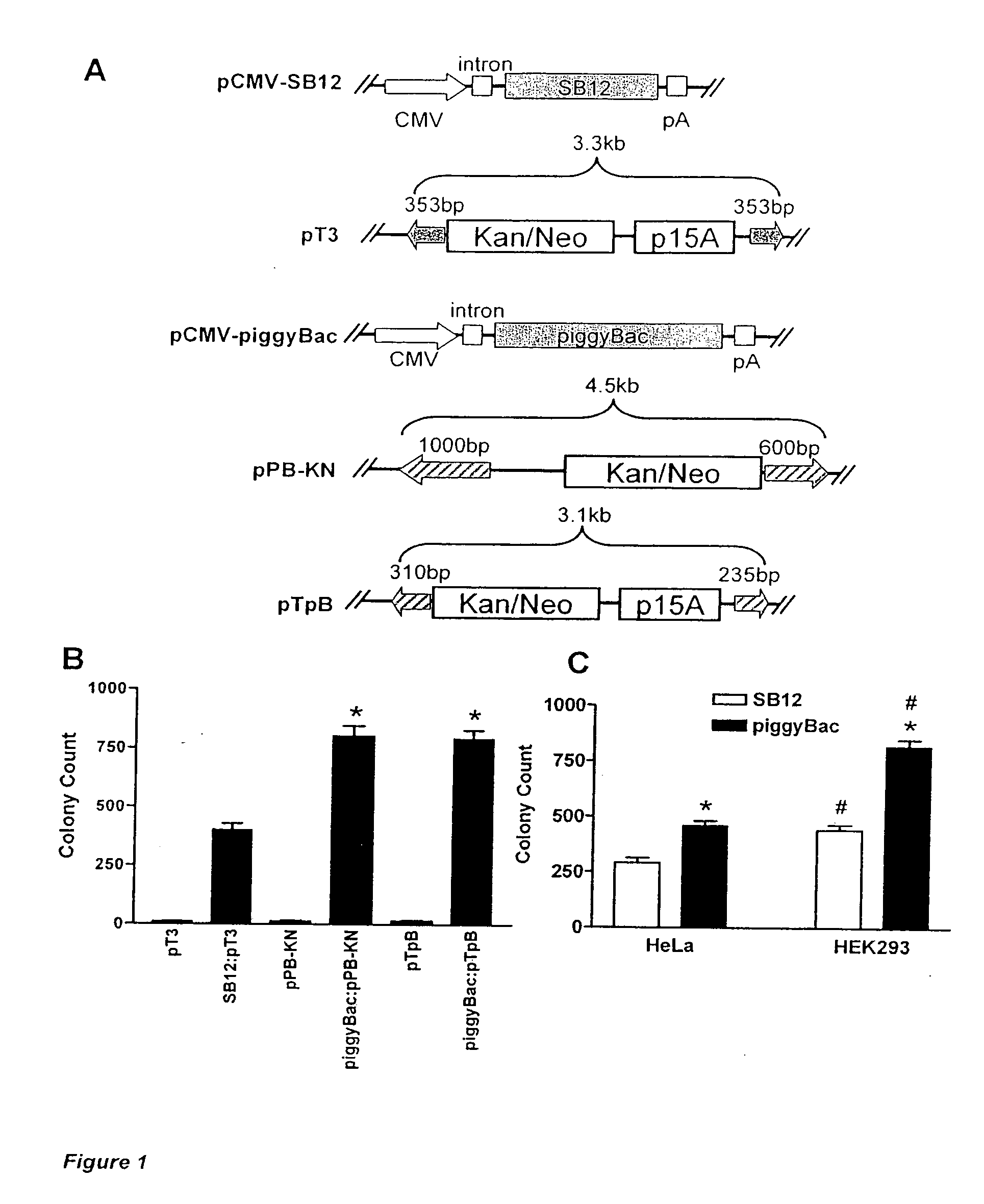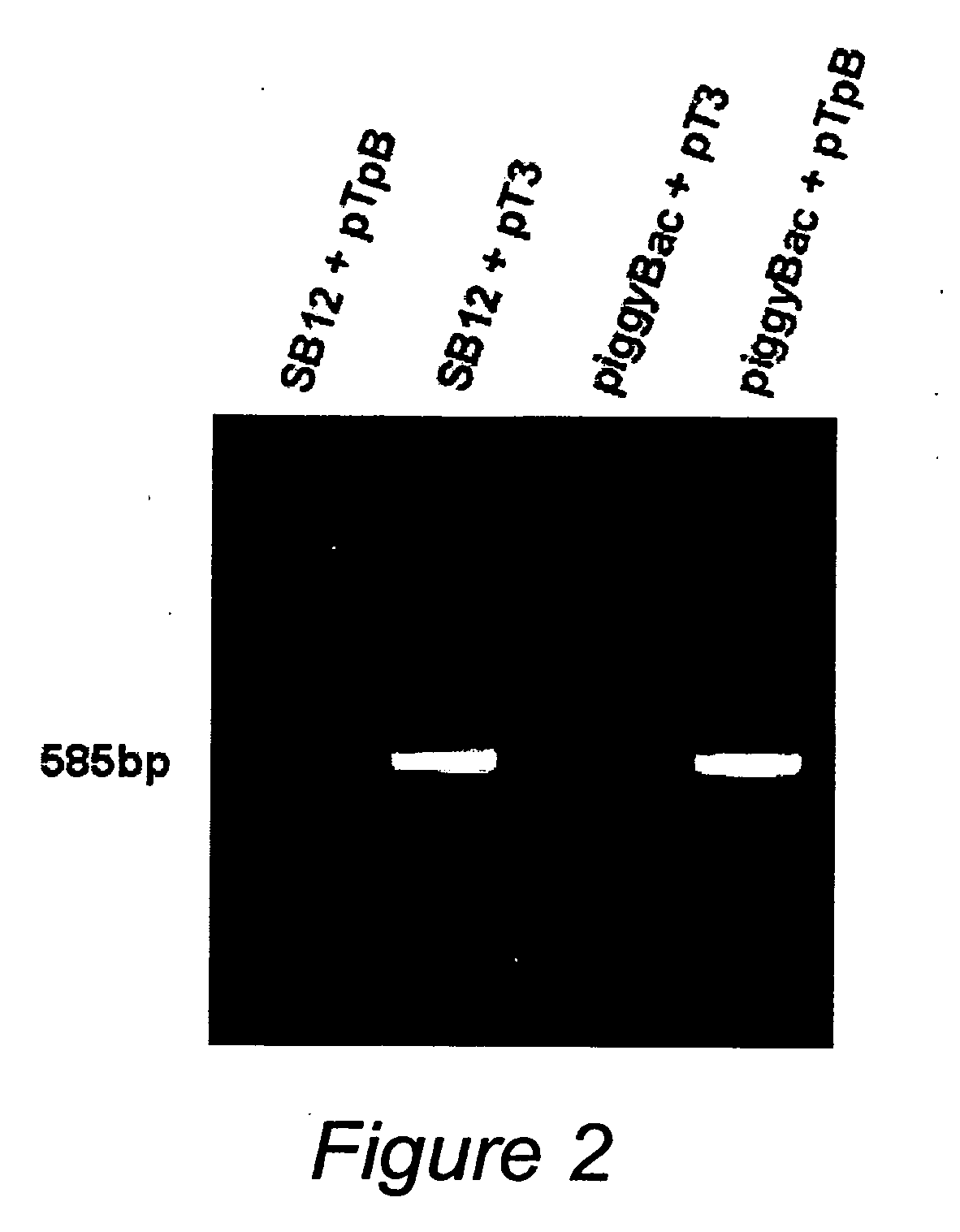Piggybac transposon-based vectors and methods of nucleic acid integration
a technology transposon, applied in the field of piggybac transposon-based vectors and methods of nucleic acid integration, can solve the problems of sb transposition, the phenomenon of affecting the efficiency of gene transfer in cultured cells and in vivo, and the inability to characterize piggybac transposition in human cells
- Summary
- Abstract
- Description
- Claims
- Application Information
AI Technical Summary
Benefits of technology
Problems solved by technology
Method used
Image
Examples
example 1
1. Example 1
PiggyBac Transposon-Mediated Gene Transfer in Human Cells
[0296]Plasmid DNA. pCMV-SB, SB12 and pT3 have been described previously [4, 5, 10]. pBac[3XP3-EGFPafm] and the piggyBac transposase (“helper”) plasmid have been described previously [23, 24]. A kanamycin / neomycin resistance cassette was created by PCR from pIRES2-EGFP (Clonetech, Mountain View, Calif.) and subcloned into the BglII site of pBac[3XP3-EGFPafm] creating pPB-KN. The piggyBac helper plasmid was digested with BamHI followed by creation of blunt ends with Klenow and restriction digestion with SacII. This piggyBac transposase fragment was then subcloned into SacII and PsiI digested pCMV-SB to create pCMV-piggyBac. To create pTpB, PCR was used to replace the left IR (LIR) element of pT3 with the minimal 311 bp LIR of piggyBac and the right IR (RIR) of pT3 was replaced with the minimal 235 bp RIR of piggyBac [18]. Combination “helper-independent” transposase-independent”transposase-transposon vectors were gen...
example 2
a) Example 2
PiggyBac Mediated Multi-Gene Integration In Vitro and In Vivo
[0313]Plasmids with multi-transgene transposons were constructed using standard recombinant DNA methods. All plasmid constructs were confirmed by restriction digestion and DNA sequencing. HEK-293 cells were grown in Dulbecco's Modified Eagle's Medium supplemented with 10% fetal bovine serum (Atlanta Biologicals, Norcross, Ga.), L-glutamine (2 mM) and penicillin-streptomycin (50 units / ml and 50 μg / ml, respectively) in a humidified, 5% CO2 atmosphere at 37° C. Cells were co-transfected with both transposon plasmids illustrated in panel A (FIG. 11) with (+transposase) or without (-transposase) a plasmid encoding the piggyBac transposase (pCMV-piggyBac) using FuGENE 6 (Roche Applied Science). Seventy-two hours after transfection, the cells were passaged and placed under dual selection with puromycin (3 ug / mL) and G418 (800 ug / mL) for 3 weeks. One set of puromycin / G418 resistant cells were stained with methylene blu...
PUM
| Property | Measurement | Unit |
|---|---|---|
| sodium current | aaaaa | aaaaa |
| Tm | aaaaa | aaaaa |
| Tm | aaaaa | aaaaa |
Abstract
Description
Claims
Application Information
 Login to View More
Login to View More - R&D
- Intellectual Property
- Life Sciences
- Materials
- Tech Scout
- Unparalleled Data Quality
- Higher Quality Content
- 60% Fewer Hallucinations
Browse by: Latest US Patents, China's latest patents, Technical Efficacy Thesaurus, Application Domain, Technology Topic, Popular Technical Reports.
© 2025 PatSnap. All rights reserved.Legal|Privacy policy|Modern Slavery Act Transparency Statement|Sitemap|About US| Contact US: help@patsnap.com



